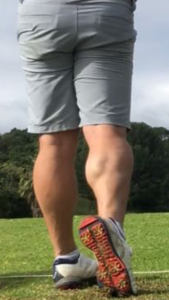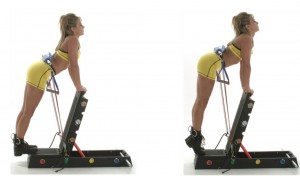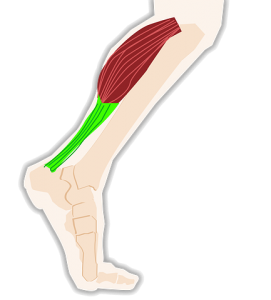
Building the muscles that make up your calves can help alleviate foot pain as well as give your legs some nice shape. Image by Bigdrewdle/Wikimedia
Last week we recommended strengthening your calves as a way to alleviate plantar fascia pain so this week’s blog is dedicated to giving a little more direction on how you can go about doing that. The good news is that it doesn’t take a ton of time to work your calves–only about 15 minutes a day at least three days a week, according to Muscle and Fitness. While some experts say you can work your calves up to five times a week, we say you’ll get better results if you keep it between one and three times a week. Calf muscles notoriously recover fast but over-training any muscle group won’t give it enough time to rest, and it’s during rest periods when you’re not working the muscle that it will strengthen and grow. Bodybuilding.com says that means giving your calves 48 to 72 hours between workouts, and that averages out to barely three to four workouts in 7 days time if you go with the minimum rest period.
They’re Called “Calves” For a Reason
The reason “calves” is plural isn’t that you’ve got two legs. It’s because there are actually three muscles that make up the entire calf muscle group. In the anatomy of the legs, those muscles are the gastrocnemius, the soleus, and the tibialis anterior. Technically, the tibialis anterior runs down the front of your shin, but all three muscles work together to move your foot up and down at the ankle joint, so it’s essential to work them all as part of a calves-strengthening regimen.
So Many Exercises to Choose From
 Movements that get you on your toes or drop your heel to flex your toes upward are the ones that will strengthen your calves. Considering that those are only two actions, you might be surprised at the extensive list of exercises ExRx.net has for strengthening the calves. They’ve thoughtfully grouped them into exercises that work each of the muscles that make up the lower legs but, once you get to studying them, you’ll see that they’re all different versions of two basic exercises: calf raises and calf presses. There are standing versions, seated versions, versions that use weights for resistance and ones that rely solely on your bodyweight.
Movements that get you on your toes or drop your heel to flex your toes upward are the ones that will strengthen your calves. Considering that those are only two actions, you might be surprised at the extensive list of exercises ExRx.net has for strengthening the calves. They’ve thoughtfully grouped them into exercises that work each of the muscles that make up the lower legs but, once you get to studying them, you’ll see that they’re all different versions of two basic exercises: calf raises and calf presses. There are standing versions, seated versions, versions that use weights for resistance and ones that rely solely on your bodyweight.
It’s useful to note that if you perform seated leg curls with your feet flexed (toes pointing up), you’ll target your calves as well as your hamstrings. And, in fact, the position of your feet as you perform all calves exercises tweaks the angle at which your muscles get worked and will help build lower-leg muscles faster. Joe Wuebben of Muscle and Fitness1 recommends doing each exercise three times with your feet positioned differently each time: toes pointed outward, toes pointed forward, and toes pointed inward.
Also interesting is that ExRx.net includes a small fourth muscle in the calves group: the popliteus. It’s the muscle in the back of your knee that connects your hamstrings to the muscles in the lower part of your leg, so it’s important not to ignore it when strengthening your calves. The exercise website recommends hamstring exercises that involve knee flexion movements to target this small but significant muscle.
Sample Calf Workout

Using bands for your calves workout is a safe way to add resistance for building muscle and they won’t tax your joints.
With a ton of calf exercises to pick from, you can do a different routine every time you work your calves. To make it easy, pick one exercise to target each calf muscle and do 3 sets of 10 to 12 reps of them on calves day. For example, you could do standing barbell calf raises, seated lever plate-loaded calf raises, and reverse calf presses (done off the top of the platform on the hip sled). Once you’ve mastered those or hit a plateau, then try out the other types of raises and presses. In addition to building stronger lower-leg muscles and easing your foot pain, you’ll get some nice definition in your calves–just the kind you want during swimsuit and shorts season.
1Wuebben, Joe. “The Level Up Series: Calves.” Muscle & Fitness. May 2017: 127

